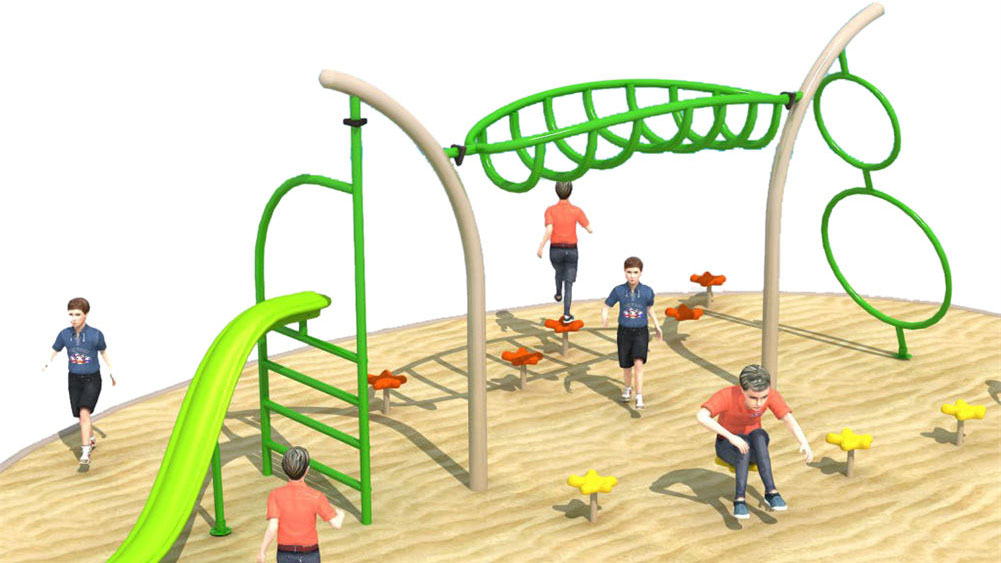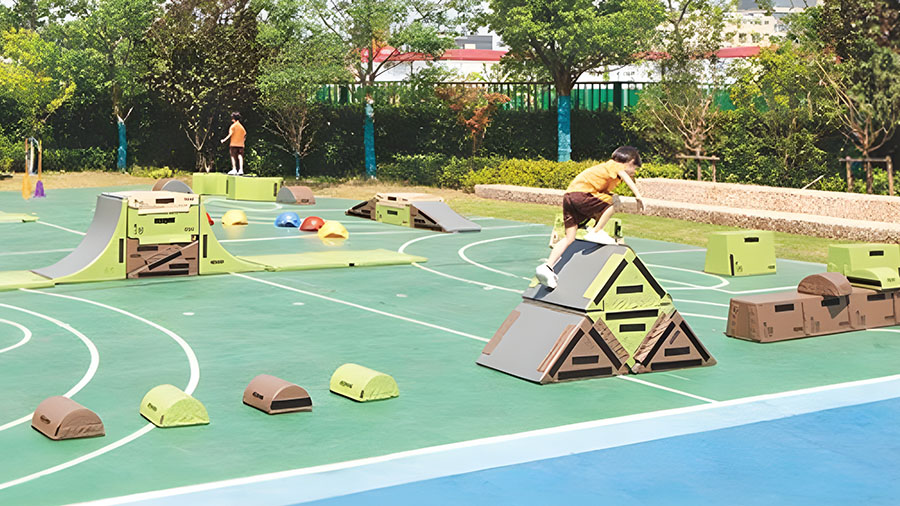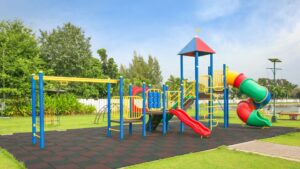Los parques infantiles son espacios esenciales para que los niños jueguen, hagan ejercicio y desarrollen importantes habilidades físicas y sociales. Tanto si está planificando una zona de juegos para un colegio, un parque o un centro comunitario, es fundamental conocer los distintos tipos de equipamiento para zonas de juegos. En este glosario, exploraremos los nombres más comunes de los equipos de parques infantiles y sus funciones, asegurándonos de que esté equipado con los conocimientos adecuados a la hora de planificar su próximo proyecto de parque infantil.
Introducción a los parques infantiles
Los parques infantiles ofrecen a los niños un entorno seguro y estimulante para desarrollar habilidades esenciales, desde la actividad física hasta la interacción social. Los parques infantiles bien diseñados se adaptan a niños de diferentes edades y capacidades, y ofrecen diversos equipos de juego como columpios, toboganes y escaladores que fomentan el desarrollo. Comprender los distintos términos y categorías de equipamiento de parques infantiles le ayudará a crear un espacio divertido y funcional para el disfrute de los niños.
Nombres tradicionales de los juegos infantiles
Con el tiempo, los equipos de los parques infantiles han evolucionado para cumplir las normas de seguridad modernas. Algunas de las piezas conocidas se han actualizado o rebautizado para mejorar la seguridad y la accesibilidad. Exploremos los nombres tradicionales de los juegos infantiles y las variaciones modernas de cada pieza.
1. Merry-Go-Round
También conocido como hilanderos, rotondaso carruselesLos tiovivos son los clásicos juegos infantiles en los que los niños giran empujando el aparato. Aunque sigue siendo común, el término "tiovivo" se utiliza a menudo indistintamente con juegos infantiles giratoriosque ha evolucionado para cumplir las modernas directrices de seguridad establecidas por la CPSC (Comisión para la Seguridad de los Productos de Consumo).
2. Balancín (Teeter-Totter)
En balancíntambién conocido como balancín, permite que dos niños viajen arriba y abajo. Nuevos dispositivos de seguridad, como centros de primavera para amortiguar los impactos, han sustituido a las versiones antiguas. El ángulo máximo de un balancín tradicional se limita ahora a 25 grados para garantizar un juego seguro.
3. Zancada gigante
En paso de gigante era un elemento muy popular en los parques infantiles, consistente en un poste alto con cuerdas colgando. Los niños se agarraban a las cuerdas y corrían, creando un movimiento giratorio. Sin embargo, debido a problemas de seguridad, este equipo se ha ido eliminando progresivamente y la CPSC ya no lo recomienda.

4. Barras de mono
Barras son escaleras horizontales suspendidas sobre el suelo, en las que los niños se balancean de barra en barra, mejorando la fuerza y la coordinación de la parte superior del cuerpo. A lo largo de los años, se han adaptado a diversas formas, como escaladores de anillas o escaladores aéreosofreciendo experiencias más desafiantes y dinámicas para los niños.
5. Anillos de alambique
Sigue sonandosimilares a los utilizados en gimnasia, se cuelgan de cadenas y permiten a los niños practicar el columpio y el balanceo. A menudo se denominan anillos terapéuticos para las manos debido a sus beneficios en el desarrollo de la fuerza de la parte superior del cuerpo.

Nombres de parques infantiles modernos
Los parques infantiles modernos cuentan ahora con una gama de nuevos equipos diseñados para maximizar la diversión, la seguridad y la accesibilidad. La incorporación de equipos innovadores fomenta juego activo, coordinacióny pensamiento crítico. He aquí un vistazo a los nombres contemporáneos de equipamiento para parques infantiles que están causando sensación en los diseños de parques infantiles de hoy en día.
1. Columpios
Los columpios siguen siendo un elemento básico de los parques infantiles, pero hay muchas variaciones a tener en cuenta:
- Oscilación del acelerador: Un gran columpio en forma de disco que permite que varios niños monten juntos.
- Generación Swing: Un columpio que combina un asiento cerrado para niños pequeños y un asiento abierto para adultos, fomentando la interacción familiar.
- Columpio Víbora: Un columpio de grupo con un diseño de cuerda, donde la cooperación es clave para lograr el movimiento.
- Asiento basculante incluido: Diseñados para niños de todas las capacidades, estos asientos proporcionan un viaje seguro y cómodo para niños con diferentes necesidades.
2. Diapositivas
Los toboganes siguen siendo uno de los juegos infantiles más apreciados. Las variaciones incluyen:
- Diapositivas de tubo: Toboganes cerrados para un viaje emocionante y rápido.
- Correderas curvas: Toboganes ondulados o en espiral que añaden emoción a la atracción.
- Torre de toboganes: Toboganes independientes unidos a una estructura en forma de torre, ideales para sistemas de juego más grandes.
3. Escaladores para parques infantiles
Las escaladoras son una forma emocionante de que los niños desarrollen la fuerza y la coordinación. Los escaladores modernos tienen varias formas:
- Escaladores geodésicos: Escaladores en forma de cúpula formados por triángulos metálicos interconectados.
- Trepadores: Escaladores diseñados para parecerse a lianas naturales para una experiencia más aventurera.
- Paredes de escalada vertical: Para los niños mayores, las paredes verticales ofrecen una escalada más desafiante.
4. Jinetes de primavera
Son piezas clásicas que siguen siendo un elemento de juego divertido e imaginativo. Los correpasillos suelen tener forma de animales o vehículos y permiten a los niños rebotar hacia delante y hacia atrás, fomentando el equilibrio y la coordinación.

5. Hilanderos
Los spinners son similares a los antiguos tiovivos, pero con diseños más modernos y características de seguridad. Los tipos incluyen:
- Spinner Barrel Ride
- Girador de sillín
- Remolino giratorio
Proporcionan una estimulante experiencia de giro y ayudan a desarrollar el sentido del equilibrio y la coordinación del niño.

6. Juegos infantiles sensoriales
Juegos sensoriales involucra a los niños a través de sus sentidos, potenciando sus capacidades cognitivas y motoras. Puede incluir:
- Paneles musicales: Instrumentos como xilófonos y tambores que estimulan los sentidos auditivos.
- Paneles de juego táctiles: Paneles texturizados diseñados para captar el sentido del tacto.
- Pasillos sensoriales: Caminos que fomentan la exploración a través de diferentes texturas.

Instalaciones
Al diseñar un parque infantil, las instalaciones son tan importantes como los juegos. Garantizan el confort y la comodidad de padres y cuidadores. Común servicios del sitio incluyen:
- Bancos
- Mesas de picnic
- Papeleras
- Aparcabicicletas
Estas características ayudan a transformar un parque infantil en un espacio comunitario acogedor para todos.
Conclusión: Comprender la terminología de los equipos para parques infantiles
Conocer a fondo los términos relacionados con el equipamiento de parques infantiles le ayudará a tomar mejores decisiones a la hora de diseñar o modernizar un parque infantil. En columpios a hilanderos y paneles sensorialesCada pieza del equipamiento tiene una función única: fomentar la actividad física, las habilidades sociales y la imaginación. Dar prioridad a la seguridad, la accesibilidad y la inclusión garantiza que todos los niños disfruten y estén seguros en el parque infantil.




